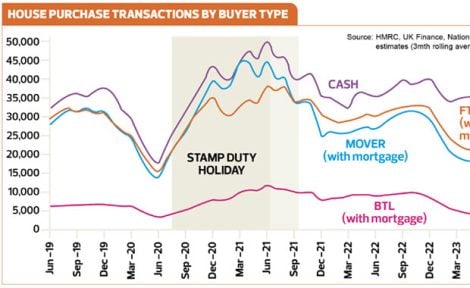View from the top
Each month we visit three agents across the country to discover what is happening in their businesses and local markets. This month we visit West Sussex, Salford and South East London.
Burgess Hill, West Sussex

Terry Wilmot is the Managing Director at Carnabys in Burgess Hill, West Sussex.
In the past 12 months property prices in Burgess Hill and the surrounding villages have dramatically surged.
Demand is outstripping supply but there are a couple of large developments in the pipeline which could bring thousands of new homes onto the market and address this issue, whilst further stimulating the market.
What Burgess Hill benefits from most is a fantastic location. It has superb train links into Brighton and central London, Gatwick Airport is a 20 minute drive away and a recently much improved A23 provides easy access to the M23 and M25.
It is surrounded by some beautiful countryside and attractive, unspoilt villages including Hurstpierpoint, Hassocks and Ditchling.
We serve a real cross-section of buyers and tenants, including Gatwick airport workers, central London commuters and young families looking to move up the property ladder.
Many of the buyers registering with us are moving from Brighton and Hove and outer London.
Three and four bedroom detached houses are the most in demand from a sales perspective but we also have a huge amount of interest in people looking to live in apartments in the town centre. There’s also a big appetite among buyers and renters for new build properties.
Pharmaceuticals company Roche and American Express have large offices in the town and this has brought in a lot of people wanting to rent locally. This influx of professionals should also help local business owners.
Our lettings portfolio is extremely healthy as is the block management side of our business.
There is a lot of healthy competition among estate agents in the town but I am sure that can be said of anywhere in the country where people want to live and work.
We have been in the local area for 15 years, having originally opened in nearby Hassocks and this year we celebrated our 10th anniversary of being in Burgess Hill.
There is still untapped potential in the town and having lived here for more than 18 years I still find it a great place to live and run a business.
The future looks very bright!
Mistoria in Salford

Jerry O’Brien is the Manager at Mistoria in Salford.
Salford is unusual in the geographical landscape of the UK, as, with Manchester it is a city next to a city – indeed Salford’s borders reach into the heart of Manchester. Salford has been the forgotten cousin to Manchester, with no Premiership football teams to promote us on the international stage, no airport to attract visitors and businesses and no concert arena attracting international superstars.
But over the last two decades Salford has started to appear from under the shadow of its red and blue noisy neighbour. Two major factors have defined Salford’s growth on the property radar; firstly in the early 90s, the development of Salford Quays started after a £280m investment allowed the conversion of derelict land alongside the Manchester ship canal to be transformed into an upmarket leisure, retail and residential waterfront development, with The Lowry theatre, the Imperial War Museum, and an outlet shopping mall. In more recent times, the BBC and ITV have both added regional studios and offices to the development providing a much needed boost to the local economy.
In 1996 University College merged with the University of Salford not hugely significant, but in 2015 the University of Salford welcomed 20,000 students across its educational threshold. Today’s Salford is a booming city for property sales, with a two bedroom terrace house starting from as little as £70,000, while the average sales price is still sub-£100,000, making it ideal for first-time buyers.
As the student population grows with a distinct lack of HMO properties, it is the ideal opportunity for investors to purchase properties to tap into the lucrative student market. The average sale price in this sector is £180,000.
At Mistoria, our lettings agency specialises in the student sector and for the full hands off service we charge a 10 per cent fee. We offer a unique turnkey service for investors, providing fully renovated and tenanted HMO properties that provide income from the first day after completion the lettings service is offered as part of the sale agreement. This has attracted a wide variety of investors, especially expats and overseas nationals, while a growing number of UK residents living in the south of England are also starting to look north for higher rental yields.
This year has been a particularly successful one for Mistoria with the launch of residential sales and lettings departments in Salford and a new branch in Liverpool. Across both branches we have agreed 600-plus new tenancies this year with close to 60 residential and investment sales completed. Initial signs are that we are looking at a very bright and busy 2016.
Forest Hill, south east London

Benjamin Matthews is the Founder and Managing Director of Benjamin Matthews Estate Agents in Forest Hill, South East London.
Forest Hill has enjoyed some very healthy growth over the last six years and the market has remained strong throughout 2015. My family and I moved to the area nearly ten years ago and it has changed considerably during that time.
The main reason for this has probably been the opening of the East London Line which made it possible to get to East London and Canary Wharf in just 15 minutes.
This has had a big effect on the area and brought an influx of new people keen to take the opportunity of great transport links, good primary schools, some fantastic open spaces and affordable homes.
Many people are being priced out of areas like Clapham and Wandsworth and are quite rightly seeing Forest Hill as an attractive option.
There is a real mix of properties available. We have on our books, Victorian three bedroom houses, 1930’s built three and four bedroom semi-detached properties going right up to six bedroom detached houses along with reasonably new build flats.
The type of buyer we see most would be couples in their mid-thirties to forties with children looking for three to four bedroom houses. A trend I am seeing often is a desire for a ‘spare’ room which can be used for a home office or study.
Commercially, we are seeing more and more independent businesses open up, in particular coffee shops and gastro pubs.
The Horniman Museum and some lovely parks also act as a magnet for people wanting to live close to the city but without having to pay an inflated premium.
In terms of potential growth areas nearby, I would be looking at Catford as an area with unrealised potential. Brockley and East Dulwich are other areas that are performing well on the market.
Like many areas across the UK, supply is a problem here. There is not enough stock and in a highly built up area there is not much space to build new homes. This has contributed to prices in SE23 remaining consistently strong.







